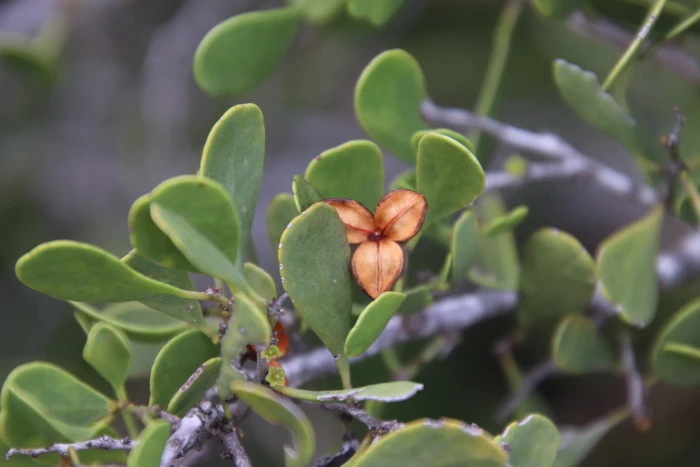Florida Mayten
(Tricerma phyllanthoides)
Florida Mayten (Tricerma phyllanthoides)
/
/

Millie Basden
CC BY 4.0
Image By:
Millie Basden
Recorded By:
Copyright:
CC BY 4.0
Copyright Notice:
Photo by: Millie Basden | License Type: CC BY 4.0 | License URL: http://creativecommons.org/licenses/by/4.0/ | Rights Holder: Millie Basden | Publisher: iNaturalist | Date Created: 2019-11-16T09:28:19-08:00 |














































Estimated Native Range
Climate Requirements for Beaumont, Texas
| This Plant | Your Site | Plant Suitability for Your Location | ||
|---|---|---|---|---|
| • Precipitation | 2" - 86" | 56" | Aquatic | Aquatic |
| • High Temp. | 75°F - 105°F | 93°F | Your summer temperatures are normal for this plant. | Excellent |
| • Low Temp. | 23°F - 112°F | 42°F | Your winter temperatures are normal for this plant | Excellent |
This plant may not grow well at your location - your precipitation is too high.
Summary
Tricerma phyllanthoides, commonly known as Florida Mayten, is an evergreen shrub or small tree native to coastal hammocks, pine rocklands, and sandy soils of Mexico, the Bahamas, Cuba, and Florida. It typically grows to a height of 15-20 feet (4.5-6 meters) with a similar spread, featuring a dense, rounded crown. The Florida Mayten has glossy, dark green leaves and inconspicuous greenish-white flowers that bloom in the spring. While the flowers are not particularly showy, they are followed by small, black drupes that can attract birds and other wildlife.
Florida Mayten is valued for its drought tolerance and ability to thrive in a variety of soil conditions, including those with slow drainage. It is often used in urban landscapes, as a hedge or screen, and in coastal gardens due to its salt tolerance. Gardeners appreciate its low water requirements and its adaptability to both full sun and part shade. However, it is susceptible to root rot in poorly drained soils and may require pruning to maintain a desirable shape.CC BY-SA 4.0
Florida Mayten is valued for its drought tolerance and ability to thrive in a variety of soil conditions, including those with slow drainage. It is often used in urban landscapes, as a hedge or screen, and in coastal gardens due to its salt tolerance. Gardeners appreciate its low water requirements and its adaptability to both full sun and part shade. However, it is susceptible to root rot in poorly drained soils and may require pruning to maintain a desirable shape.CC BY-SA 4.0
Plant Description
- Plant Type: Shrub
- Height: 2-6 feet
- Width: 2-5 feet
- Growth Rate: Moderate
- Flower Color: N/A
- Flowering Season: Spring, Summer
- Leaf Retention: Evergreen
Growth Requirements
- Sun: Full Sun, Part Shade
- Water: Low
- Drainage: Slow
Common Uses
Low Maintenance, Salt Tolerant
Natural Habitat
native to coastal hammocks, pine rocklands, and sandy soils of Mexico, the Bahamas, Cuba, and Florida
Other Names
Common Names: Verdolaga
Scientific Names: Maytenus phyllanthoides, Tricerma phyllanthoides, Maytenus texana, Tricerma texanum, Maytenus phyllanthoides var. ovalifolia, Tricerma crassifolium
GBIF Accepted Name: Tricerma phyllanthoides (Benth.) Lundell